Yume Nikki and Haunting Myself through Memory
A few months ago, I was invited to my friend A’s three-day birthday celebration. We stayed at a red wood house: the white paint at the rusted frames of the windows was chipping off, the porch creaked when you stepped unto it, and it had a pool that hadn’t been used in years—instead it served as a swamp-green pond for a family of koi fish. “Who’s gonna die first?” one of us would joke, as if upon our arrival at the house we were suddenly thrown into the set-up of a campy teenage horror film. Sure enough it was just that: five to seven teenagers hanging out in an old house away from the city. We kept daring each other to jump into the swamp pool so one of us could contract a new disease and start a new pandemic. I roomed with J, who took the bottom bunk while I stayed at the top. The nights started warm and got colder the later it got, so I found it difcult to fall asleep because I could feel a body of strange air right beside me. I knew it wasn’t a malevolent entity, it was just terribly lonely and looking for warmth. I couldn’t be afraid when it was just a lonely kind of thing. It was on that first night that I told J that I loved this house. “I love it too,” She responded—referring to all the twee trinkets, artworks, and decor that made the house such a home. In a similar way, I loved the house because it was haunted.
I’m easy to scare, but I’ve been thrilled by the notions of horror ever since I was a young child granted unsupervised access to the internet. Circa 2012 to 2014, I'm young and I am entertained: Pewdiepie played Amnesia, Markiplier is playing Five Nights at Freddy’s, and everyone already played Slenderman. It was much easier to muster up simple courage when someone else was experiencing the horror. If anything, it felt comforting in that parasocial way to go along for the ride with someone else. This made it easier to be afraid when I sought to be. Back then I believed in ghosts and the supernatural because it was what occupied my idle imagination, never because I was actually afraid. There was only one horror game I played myself around this age. To keep me occupied when I got annoying, my sister would slide over to me her clunky Dell laptop jam-packed with illegally downloaded PC games, she’d boot it up, and a simple black title menu is on the screen with three options to choose from: Start, Diary, Quit. Under a blobbed vignette of a tiny white maze is a pixelated title, Yume Nikki, literally translating to Dream Diary.

Yume Nikki is a dream-exploration game developed by Kikiyama on the RPG Maker 2003 software. It was released on June 26, 2004, through a Japanese forum website called 2chan. Despite being developed on a role-playing game software, it lacks conventional role-playing mechanics—let alone any game mechanics at all. The only objective is to collect all 24 of its “effects.” These would refer to items of shape-shifting attributes that allow the main character to progress through the several areas in the game. The only semblance of battle lies in the knife effect that grants the option to kill side characters. Its premise hinges itself upon the main character’s limitation—or rather, hesitation: Madotsuki is a young girl who cannot leave her room, and if you attempt to have her open the door, she shakes her head. She does not want to leave at all. The only option is to have Madotsuki crawl into bed. In three seconds she will drift away to sleep, and awaken in her dream world. In this alternative world, her apartment door finally opens into a large room of twelve distinct doors. This area is commonly called the Nexus, and each door leads to worlds within worlds, often housing imagery so strange it is disturbing. Flashing colors pulsating enough to induce migraines, strewn-about eyeballs and severed hands emerging out of a pitch-black floor, phallic alien creatures following Madotsuki around. All of this is accompanied by a heady soundtrack where most tracks don’t even go beyond five notes.
Yume Nikki continues to be considered a cult classic within the role-playing horror subgenre of PC games, despite it not having claimed to be a horror game to begin with. Contemporary game developers of the genre return to this game when discussing inspiration for their respective projects, such as the creators of Omori (2020) and Lisa (2012). It is also the predecessor of a surge of fan games that utilize its exact same artstyle and premise (Yume 2kki, .flow, LCD DEM, etc.). Evidently, the game’s community is rich with participation. With the lack of game mechanics and recognizable plot, fans have taken to analyzing Yume Nikki. From Madotsuki herself, to side characters of the game, to the game’s ending. This exploration into her dreams invites the players into Madotsuki’s psyche, but the absence of plot and dialogue only compel further speculation. Most of these discussions are held across niche corners of the internet: in forums, comments on videos, and blog posts. Several of the names of areas, side characters, and events are courtesy of both the Japanese and Non-Japanese fanbase.
In Yume Nikki, several events and areas are discovered only through pure probability. There’s only a 1/3600 chance of ever encountering one of the rarest occurrences in the game. Besides this, each of the 24 effects are scattered around the several worlds in random areas. To finish Yume Nikki, it is necessary to explore, and explore for hours. If you wake up, there’s no way of instantly returning to the point where you were in the dream. You depend on chance again, constantly moving back and forth between a waking state and a dreaming one. This is what can make the game so frustrating, and even at some point boring. Nevertheless, I played it. Two of the notable events are Kyuukyuu-kun, and the FACE event.
Triggering them requires Madotsuki to enter the Number World—the first purple door to Madotsuki’s left in Nexus. The soundtrack that envelopes this area is a repetition of deep timbres on a reverberating bell toll, crunching at the seams and overlaid by its own echoes. Clusters of numbers inked red are stamped into the world’s floors; floors that would otherwise be a void of black if it weren’t situated upon a drifting underlay of this world’s own self. The walls are patterns of cartoon creatures with an arm for an arm, a foot for the other arm, and a zipper for a body. There is a ⅙ chance that upon making one’s way towards the southeast end, one of these creatures will look slightly different from the rest. Its mouth is open in a frown. Have Madotsuki stab the wall with a knife and it screams—gashing itself open into a bleeding entrance, then leading into a narrow hall and a metal banister.
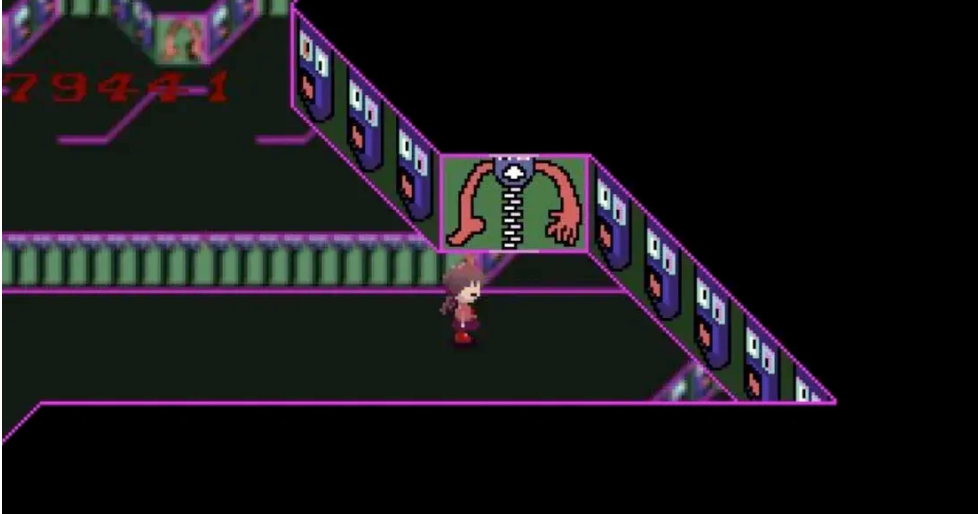
It’s a short walk before Madotsuki encounters a staircase, and then the elongated worm-bodied creature standing behind it. Named after the Japanese onomatopoeia for the squeaking against surfaces (きゅうきゅう), Kyuukyuu-kun is colored a visceral red, yellow, and green against the black wall. It is rubbing its hand against the banister. It rubs faster the closer Madotsuki approaches it. There is no music in this room, the only sound being his shrill strokes against the staircase’s metal. Even if the player tries, she cannot stab it. Its face is a smiling one, static and lifeless. There is nothing else to do in the room except to enter the door at the top of the staircase. Enter, and then the whole screen is rendered black.
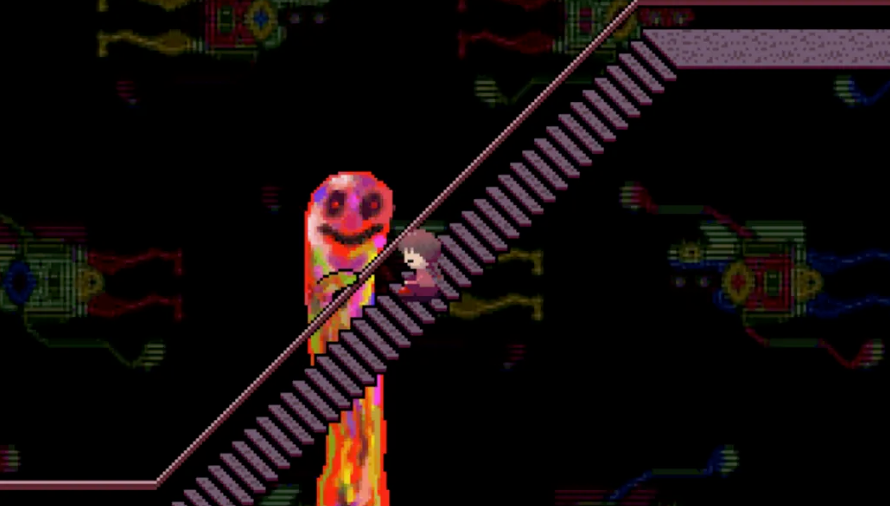
Slowly, there will begin to creep in the distance a low buzz—edging closer until the buzzing is rushing-in so loud it sounds like something is weeping.
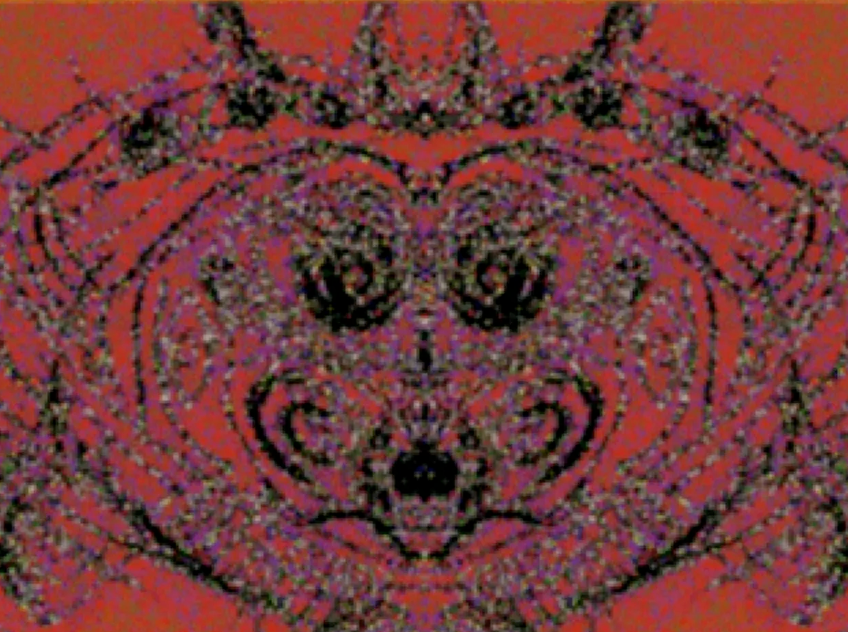
This is the FACE scene. Fans have named the entity, The Red King. Notably after this scene, Madotsuki jolts awake.
The origin of the word “haunt” is derived from Old French, hanter (meaning “to inhabit, frequent, resort to”). This implies an underlying meaning to the word. It is a force that returns: to haunt a house means you will leave it—but in some manner, you must also guarantee that you will come back.
I remember the jam-packed train car. Far away from my family, I was in the middle of the crowd, heels digging back into the floor whenever the train started and toes tipping forward when it stopped. The crowds shuffled and shifted every now and then to either make space or occupy it, so it was so consistent that strangers were flashing into new faces. But then, slowly, in the distance, a body began to emerge from the crowd—getting closer, closer, and closer until it was standing behind me. There is a buzzing noise in my head that billows out into a ringing in my ear when a hand emerges.
I simply considered: maybe it is the inertia of the train, maybe it is my imagination, maybe it is something I deserve. But when I look back at this now, I find myself considering: if I am alone, that means no one at all is here with me. No one at all.
I remember on the third night of A’s birthday party, the storm raged against the window panes. We all decided to play a horror game. Staying together, we switched the lights off in the room. The rain got stronger until the winds were pushing glasses off tables, and swaying the doors and windows. The lights went out, shrouding us all in darkness for more than three hours. We went on with the night, playing drinking games until the lights came back up. My capacity for alcohol is low enough that I’d lose myself from just a few shots of soju. With my inhibitions down, I flirted with a guy and talked to him the whole night because I thought he was cute. I would tell him all about how much I loved the house, how not all hauntings are malicious hauntings, how my ex used to make fleeting comments about wanting to take advantage of my vulnerability. He told me I should zip up my jacket because I was showing too much skin.
Later into the night the electricity would come back but it was around this time I started getting sleepy. I went up to my room alone, and was on the verge of sleeping. In the distance everyone else was clamoring about a frog that jumped in through the window. He came into the room, and closed the door, leaving me alone with him. He stepped onto the bottom bunk, lifted himself forward to face me. I don’t remember whether or not he asked permission, but I didn’t think it mattered then because I think I liked it. I think I liked it when he pressed his lips to mine. I think I liked it because I invited him towards me in the first place, I wanted this and I deserved this. After that, he left, they threw the frog back out the window, and while I am recalling all of this I am sick to my stomach to the point I want to throw up. Maybe it was the alcohol, maybe it was because I liked it then and I hate it all now. Maybe it was because after the party, a few days later, he told me about what would have happened if nobody else were there in the house. He said any longer with me and he’d regret what he’d do to me.
There is an area in Yume Nikki that I always loved. It is in one of the deeper areas, accessed through the Spaceship event that only occurs on a ⅙ chance: Madotsuki is on a spaceship, and you have to keep entering bed until the screen dims and the spaceship is crashing into an unidentified planet. Fans have simply called it Mars. There will be a steep climb up a rocky hill, and it will go on for a while before reaching the peak. There is a small hole there, with steam winding from within it. Have Madotsuki shrink, and she will walk into the hole then descend down gravel stairs. At the end of them is a bleak room—the screen slowly scrolling into what looks like a crashed train.
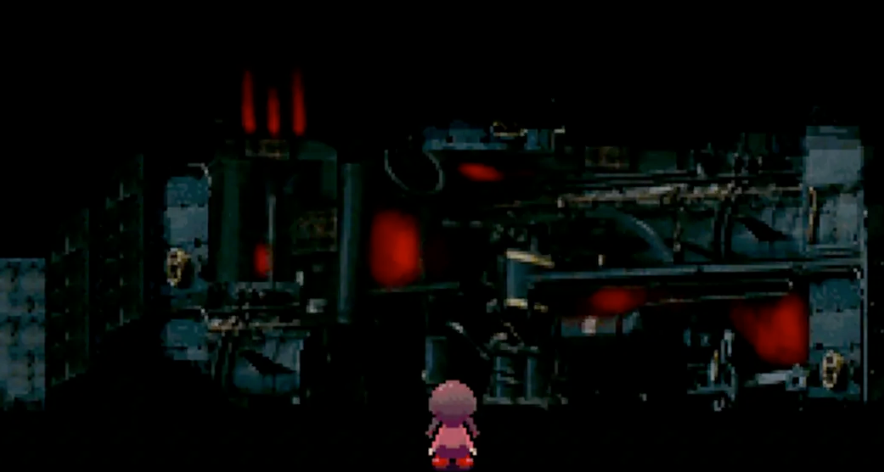
Then, a large creature standing on one foot. Its body resembles a heat map. It is all blue, with what is either an eye or a wound at the center of its face.
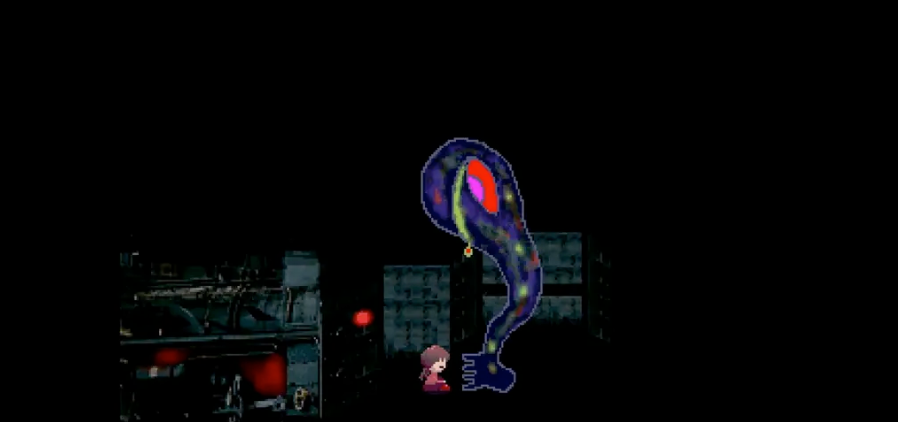
Whether it is bleeding or crying, stabbing it will only change the color or its wound-or-eye. The fanbase has no other name for it except for Mars-san. The soundtrack to this area is a series of five notes going up a scale, and interacting with the creature will have it sing a song of two notes—as if weeping, or pleading, or lamenting in response. Without its train it is stuck here in the underground, and if it’s that big, it won’t be able to fit through the hole in the mountain. It is stranded here, and Madotsuki’s only option is to stay alongside it, even if for a little while. Maybe it was a small thing once—maybe it refuses to leave. Maybe it stays because it’s waiting for something to come back. Either way, when I needed comfort back then, this was one of my favorite areas to access. There was something about sitting next to this creature that gave me solace, as if it understood me and Madotsuki both. I could be there but I couldn’t speak to it. I couldn’t reach it. I couldn’t help it get back home. We could haunt each other, but only in the most human sense of doing so: that of coming back, and returning to. That of staying.
After collecting all 24 of the effects in Yume Nikki, Madotsuki will wake up from the dream. Suddenly at the balcony there will spawn a small case of steps leading over the edge of the balcony’s fence. Madotsuki climbs it, then steps off. I never collected all 24 of the effects, I didn’t want to. I never played Yume Nikki to its end. I wanted to keep returning to it as if Madotsuki’s dreams were somehow my own. I frequented it. Remembering is similar to haunting because it promises that someone is still with me. At least something will keep coming back to me. I could keep coming back to myself, in that packed train, or in that small room, keeping her company when she was afraid.
December, 2023